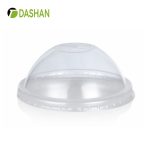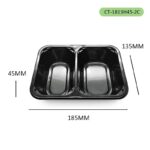Introduction
Polyethylene Terephthalate (PET) has become one of the most widely used materials in the global food packaging industry. Known for its clarity, strength, lightweight nature, and recyclability, PET packaging is a go-to choice for fruits, salads, bakery items, dairy products, beverages, and ready-to-eat meals.
With growing consumer demand for food safety, environmental sustainability, and appealing presentation, PET food packaging has evolved into a smart solution that meets both regulatory requirements and market trends.


1. What Is PET Food Packaging?
PET (Polyethylene Terephthalate) is a type of thermoplastic polymer resin in the polyester family. It is:
-
Transparent and lightweight
-
Durable and impact-resistant
-
FDA- and EU-approved for food contact
-
100% recyclable into RPET (Recycled PET)
In food applications, PET is commonly used for:
-
Salad and fruit containers
-
Cold drink cups and lids
-
Bakery and dessert boxes
-
Meat, seafood, and deli trays
-
Ready-meal clamshells
2. Advantages of PET Food Packaging
2.1 Food Safety and Hygiene
PET is non-toxic, odorless, and compliant with FDA (US), EFSA (Europe), and China GB 4806 food contact standards. It acts as a barrier to moisture and gases, preserving freshness.
2.2 Exceptional Clarity
PET offers crystal-clear transparency, allowing consumers to see the food inside. Studies show that visible food presentation increases purchase intention by 30%.
2.3 Lightweight and Strong
PET packaging weighs significantly less than glass or metal alternatives, reducing transportation costs and carbon footprint.
2.4 Sustainability
PET can be collected, sorted, and recycled into RPET for new packaging or textile fibers. Many brands now require packaging with up to 50% RPET content to meet corporate sustainability goals.
2.5 Versatility in Design
It can be thermoformed, injection molded, or blow-molded into various shapes—ideal for custom branding and innovative designs.


3. Market Trends in PET Food Packaging
3.1 Growing Demand for Sustainable Packaging
According to MarketsandMarkets, the PET packaging market is projected to grow from $81.2 billion in 2023 to $108.4 billion by 2028, driven by sustainability regulations.
3.2 Shift Toward RPET
With only 9% of global plastic being recycled, many governments are mandating the use of post-consumer recycled content in packaging.
For example:
-
EU: 25% RPET in beverage bottles by 2025
-
California: 50% RPET in beverage bottles by 2030
3.3 Customization & Branding
PET packaging is increasingly being used as a marketing tool—custom shapes, embossed logos, and vibrant labeling enhance shelf appeal.
4. PET vs Other Packaging Materials
| Feature | PET | PP | PLA (Compostable) | Glass |
|---|---|---|---|---|
| Clarity | ★★★★★ | ★★★★☆ | ★★★★☆ | ★★★★★ |
| Recyclability | ★★★★★ | ★★★★☆ | Industrial compost | ★★★★★ |
| Weight | Very Light | Light | Light | Heavy |
| Barrier Properties | High (moisture/gas) | Moderate | Low | High |
| Cost | Medium | Low | High | High |
5. Real-World Applications
5.1 Fresh Produce Packaging
Clear PET fruit clamshells showcase vibrant colors while protecting from bruising.
5.2 Salad & Deli Containers
Leak-proof PET bowls keep salads fresh, ideal for takeout and delivery.
5.3 Bakery & Dessert Boxes
Transparent lids entice customers with a clear view of cakes, pastries, and sweets.
5.4 Cold Drink Cups
PET cold cups are a staple in cafes, juice bars, and bubble tea shops.
6. Xiamen Dashan PET Food Packaging Solutions
As a trusted manufacturer, Xiamen Dashan offers:
-
PET & RPET containers for salads, fruits, bakery, desserts, and beverages
-
Custom shapes, sizes, and logo printing
-
International certifications (FDA, EU, GB standards)
-
Eco-friendly options with recycled content
-
Fast turnaround and flexible MOQ
Popular PET products:
-
Fruit clamshells (250g–1kg)
-
Salad bowls (500ml–1500ml)
-
PET cold drink cups (8oz–24oz)
-
Bakery cake domes
-
Multi-compartment deli trays


7. FAQ
Q1: Is PET packaging microwave-safe?
A: Standard PET is not microwave-safe. For microwaving, CPET (Crystallized PET) is used.
Q2: Can PET be frozen?
A: Yes, PET withstands freezing without cracking.
Q3: How many times can PET be recycled?
A: Typically 1–2 times into food-grade RPET, then into non-food products.
8. Conclusion
PET food packaging is the perfect balance of safety, sustainability, and style. With the ability to be recycled into new products, PET aligns with global sustainability goals while providing the durability and clarity that food businesses need.
As consumer expectations grow, companies like Xiamen Dashan continue to innovate with eco-friendly PET and RPET solutions that protect food, enhance branding, and reduce environmental impact.
References
-
MarketsandMarkets – PET Packaging Market Forecast (2023–2028)
https://www.marketsandmarkets.com/Market-Reports/pet-packaging-market-1177.html -
U.S. Food & Drug Administration (FDA) – Food Contact Substances Regulations
https://www.fda.gov/food/packaging-food-contact-substances/fda-regulations-food-contact-substances -
European Commission – Food Contact Materials Legislation
https://food.ec.europa.eu/safety/chemical-safety/food-contact-materials_en -
Ellen MacArthur Foundation – The New Plastics Economy
https://ellenmacarthurfoundation.org/the-new-plastics-economy -
Plastics Europe – PET Recycling Facts
https://plasticseurope.org/sustainability/circularity/recycling/polyethylene-terephthalate-pet-recycling/
Copyright Statement© 2025 Dashan Packing. All rights reserved.
This article is an original work created by the Dashan Packing editorial team.All text, data, and images are the result of our independent research, industry experience,and product development insights. Reproduction or redistribution of any part of this contentwithout written permission is strictly prohibited.
Dashan Packing is committed to providing accurate, evidence-based information andto upholding transparency, originality, and compliance with global intellectual property standards.





